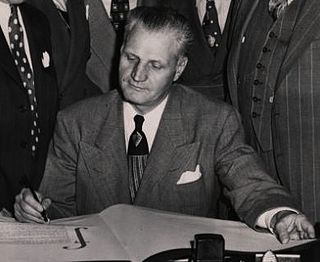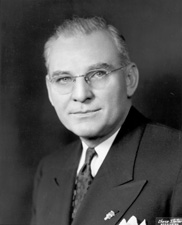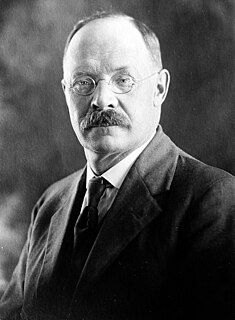This page is based on this
Wikipedia article Text is available under the
CC BY-SA 4.0 license; additional terms may apply.
Images, videos and audio are available under their respective licenses.

The 1966 Minnesota gubernatorial election took place on November 8, 1966. Republican Party of Minnesota candidate Harold LeVander defeated Minnesota Democratic–Farmer–Labor Party challenger Karl Rolvaag.

The 1960 Minnesota gubernatorial election took place on November 8, 1960. Republican Party of Minnesota candidate Elmer Andersen defeated Minnesota Democratic–Farmer–Labor Party challenger Orville Freeman.

The 1958 Minnesota gubernatorial election took place on November 4, 1958. Minnesota Democratic–Farmer–Labor Party candidate Orville Freeman defeated Republican Party of Minnesota challenger George MacKinnon.

The 1956 Minnesota gubernatorial election took place on November 6, 1956. Minnesota Democratic–Farmer–Labor Party candidate Orville Freeman defeated Republican Party of Minnesota challenger Ancher Nelsen.

The 1954 Minnesota gubernatorial election took place on November 2, 1954. Minnesota Democratic–Farmer–Labor Party candidate Orville Freeman defeated Republican Party of Minnesota challenger C. Elmer Anderson.

The 1950 Minnesota gubernatorial election took place on November 7, 1950. Republican Party of Minnesota candidate Luther Youngdahl defeated Minnesota Democratic–Farmer–Labor Party challenger Harry H. Peterson.

The 1946 Minnesota gubernatorial election took place on November 5, 1946. Republican Party of Minnesota candidate Luther Youngdahl defeated Minnesota Democratic–Farmer–Labor Party challenger Harold H. Barker.

The 1944 Minnesota gubernatorial election took place on November 7, 1944. Republican Party of Minnesota candidate Edward John Thye defeated Minnesota Democratic–Farmer–Labor Party challenger Byron G. Allen. As the Democratic Party of Minnesota and Farmer–Labor Party merged earlier in the year, this was the first gubernatorial election in which the parties ran a combined ticket. The vote change below reflects the departure from the combined Democratic and Farmer–Labor totals in 1942.

The 1942 Minnesota gubernatorial election took place on November 3, 1942. Republican Party of Minnesota candidate Harold Stassen defeated Farmer–Labor Party challenger Hjalmar Petersen. This was the last election in which the Democratic Party of Minnesota and the Farmer–Labor Party ran separate candidates; in 1944, both parties ran under the umbrella of the Minnesota Democratic–Farmer–Labor Party.

The 1934 Minnesota gubernatorial election took place on November 6, 1934. Farmer–Labor Party candidate Floyd B. Olson defeated Republican Party of Minnesota challenger Martin A. Nelson.

The 1932 Minnesota gubernatorial election took place on November 8, 1932. Farmer–Labor Party candidate Floyd B. Olson defeated Republican Party of Minnesota challenger Earle Brown.

The 1930 Minnesota gubernatorial election took place on November 4, 1930. It was the first gubernatorial race to start in Minnesota since the beginning of the Great Depression, which contributed to the meteoric rise of the Farmer–Labor Party in the state. Farmer–Labor Party candidate Floyd B. Olson decisively defeated Republican Party of Minnesota challenger Raymond P. Chase.

The 1924 Minnesota gubernatorial election took place on November 4, 1924. Republican Party of Minnesota candidate Theodore Christianson defeated Farmer–Labor Party challenger Floyd B. Olson.

The 1922 Minnesota gubernatorial election took place on November 7, 1922. Republican Party of Minnesota candidate J. A. O. Preus defeated Farmer–Labor Party challenger Magnus Johnson.

The 1918 Minnesota gubernatorial election took place on November 5, 1918. Republican Party of Minnesota candidate J. A. A. Burnquist defeated Farmer–Labor Party challenger David H. Evans. This is the first gubernatorial election in Minnesota with a Farmer–Labor candidate.

The 1934 United States Senate election in Minnesota took place on November 6, 1934. Incumbent Farmer-Labor U.S. Senator Henrik Shipstead defeated former State Senator Nathaniel J. Holmberg of the Republican Party of Minnesota and U.S. Representative Einar Hoidale of the Minnesota Democratic Party to win a third term.

The 1946 United States Senate election in Minnesota took place on November 5, 1946. It was the first election to either of Minnesota's seats in the United States Senate held since the Minnesota Democratic Party and the Farmer-Labor Party of Minnesota merged in 1944, to form the Minnesota Democratic-Farmer-Labor Party. Incumbent U.S. Senator Henrik Shipstead was defeated in the Republican primary by Governor Edward John Thye, who went on to defeat DFL challenger Theodore Jorgenson in the general election.

The 1922 United States Senate election in Minnesota took place on November 7, 1922. Farmer-Labor challenger Henrik Shipstead defeated incumbent Republican U.S. Senator Frank B. Kellogg and Democratic challenger Anna Dickie Olesen.

The 1923 United States Senate special election in Minnesota took place on July 16, 1923. The election was held to fill, for the remainder of the unexpired term, the seat in the United States Senate left vacant by Republican U.S. Senator Knute Nelson, who died in office on April 28, 1923. State Senator Magnus Johnson of the Farmer-Labor Party of Minnesota defeated Governor J. A. O. Preus of the Republican Party of Minnesota, and State Senator James A. Carley of the Minnesota Democratic Party, which, together with Henrik Shipstead's victory in 1922, brought both of Minnesota's seats in the United States Senate into the hands of the Farmer-Labor Party for the first time in history.

The 1928 United States Senate election in Minnesota took place on November 6, 1928. Incumbent Farmer-Labor U.S. Senator Henrik Shipstead defeated his Republican challenger, former St. Paul mayor Arthur E. Nelson, to win a second term.

















